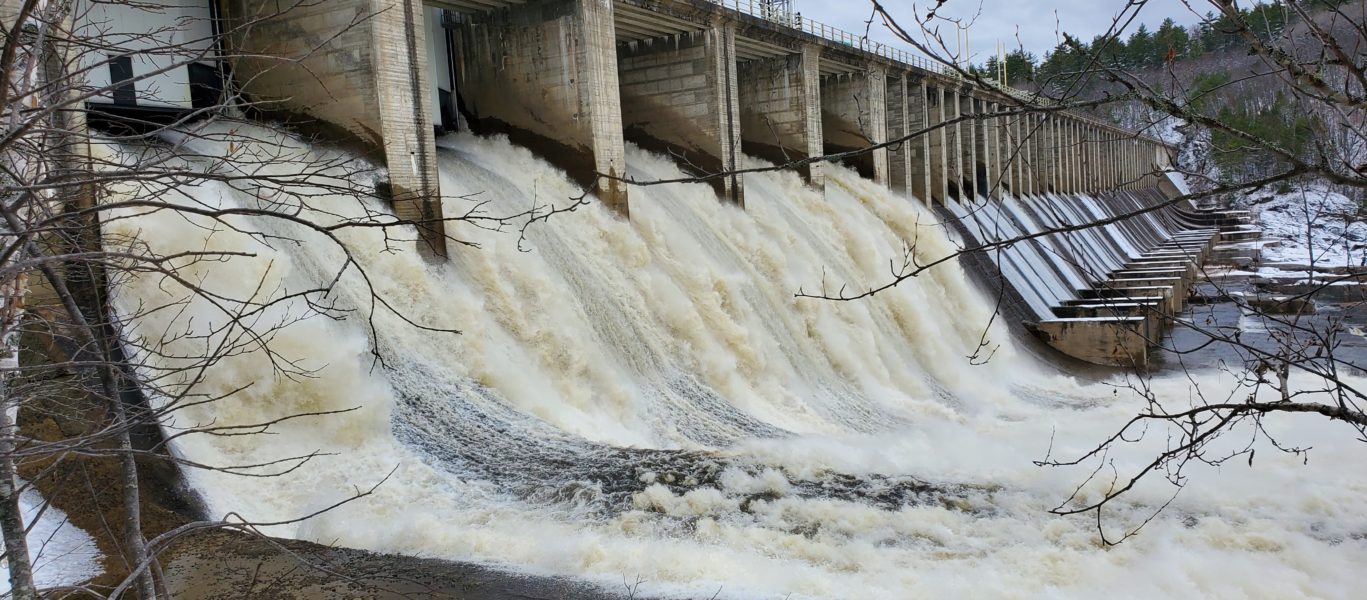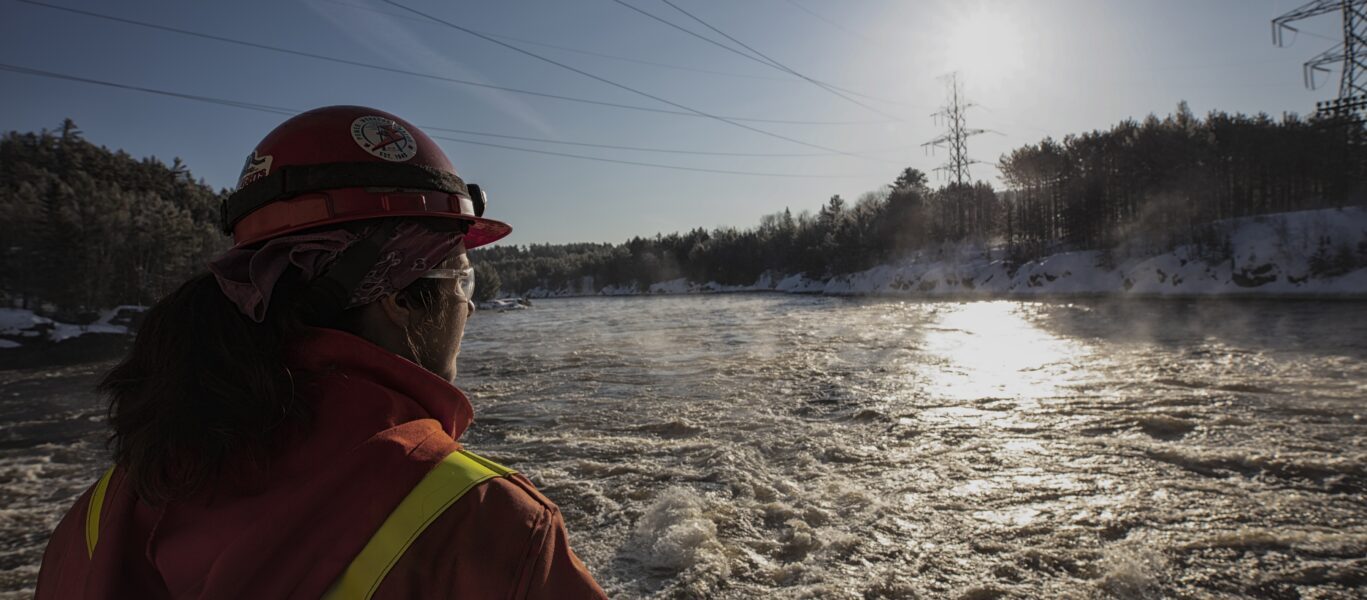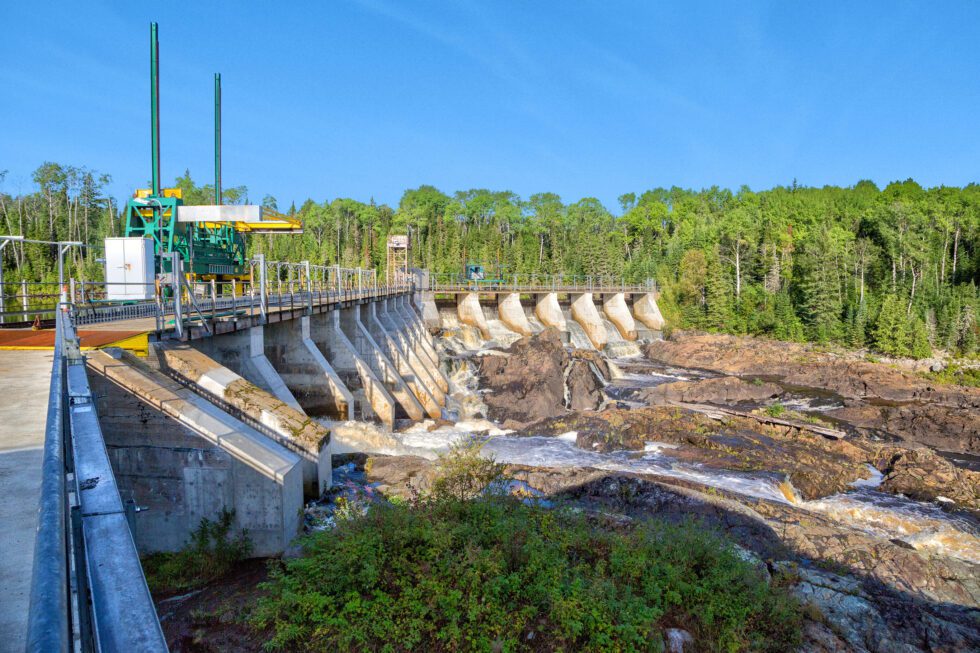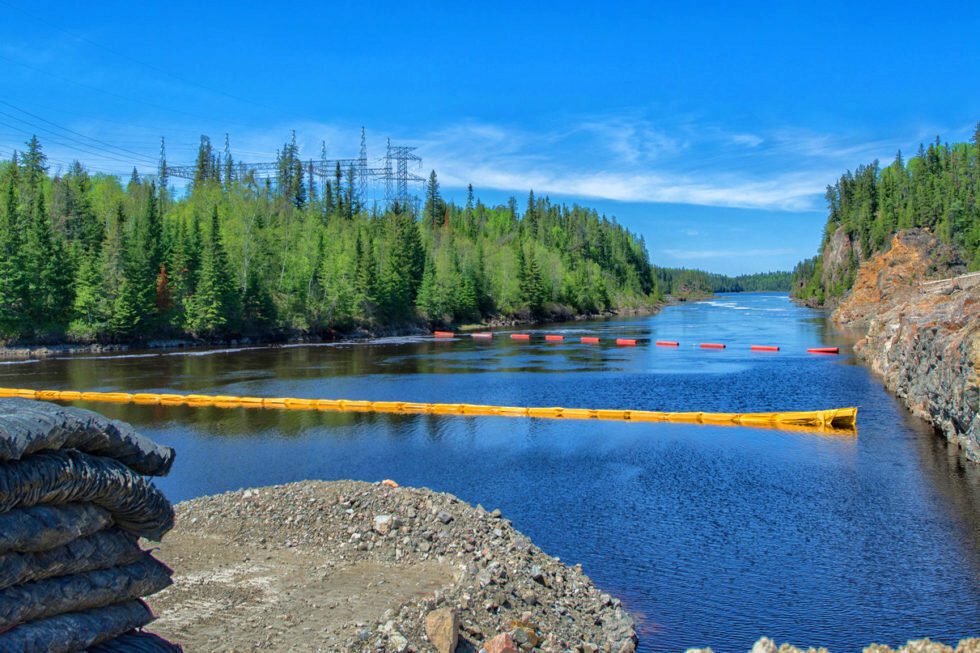Water management
We work with nature
Every year, we work with government agencies, scientists, municipalities and most importantly, nature, to predict conditions and manage our river systems for the safety of people and the environment.
As warmer temperatures set in, Ontario Power Generation's (OPG's) operations staff across the province are already busy managing the impacts of Freshet, the annual spring runoff that occurs when snow melts and spring rains fall.
Freshet is an important but often misunderstood annual phenomenon that affects Ontario's hydroelectric operations and the people who live on or use the affected river systems.
Predicting water levels can be very difficult, and our employees must balance many factors including public safety, limited reservoir storage capacity, environmental stewardship, and local water management plans and agreements, to determine allowable limits for managing the holding or release of water from our many dams on rivers across Ontario.
On large river systems like those in Ontario, spring Freshet can take up to several weeks. Regardless of water levels, please be safe around rivers and dams as water levels can change in an instant. Learn more at opg.com/watersafety
Fast facts
0
393390
km2 of land area within OPG's watershed (estimated)
239
dams on 24 river systems across Ontario
0
276
billion m3 in OPG's total storage capacity
0
576
billion m3 of water managed by OPG in 2024

What is nature up to this year?
Ontario's watersheds
Find out what OPG is doing to manage water in each regional watershed.
Eastern Ontario
Our Eastern Ontario regional watershed is home to 15 hydroelectric stations situated on six river systems including the Ottawa, Madawaska, St. Lawrence, Mississippi, Trent and Rideau.
Regional watershed partners
As we work to predict conditions and manage river systems for the safety of people and the environment, we work with many partners and agencies in this region including:
- The Ontario Ministry of Natural Resources and Forestry Services
- Ottawa River Regulation Planning Board
- International Lake Ontario-St Lawrence River Board
- Parks Canada
- Mississippi Valley Conservation Authority
- North Bay-Mattawa Conservation Authority
- Rideau Valley Conservation Authority
- Lower Trent Conservation
- Hydro Quebec
- Public Services and Procurement Canada
- Ministère de l'Environnement et de la Lutte contre les changements climatiques
Challenges
Areas where the river narrows or becomes shallow (e.g., rapids) can cause water to backup upstream of these narrows when water flows are high. High flows at natural river restrictions can require special water management strategies for flood mitigation at nearby dams.
Water management plans
We work with our watershed partners and the Ministry of Natural Resources and Forestry (MNRF) on a balanced approach to water management on the Madawaska River that considers the various interests of many users.
This work produces the Madawaska River Water Management Plan, which includes operational plans for each waterpower facility or dam; provisions for management of water levels and flows; stakeholder communication; and environmental programming.
River system data
Please visit water.opg.com
Public engagement
For more information about our operations, please see the following water management overview presentations and recordings of town hall sessions:
South and Central Ontario
Along with our operations at the Sir Adam Beck Complex on the Niagara River, OPG operates 20 stations in central Ontario including facilities on the Muskoka, Severn, Beaver, and Musquash rivers.
Regional watershed partners
As we work to predict conditions and manage river systems for the safety of people and the environment, we work with many partners and agencies in this region including:
- The Ontario Ministry of Natural Resources and Forestry Services
- Otonabee Conservation
- Parks Canada (for Big Chute Generating Station)
- Trent Severn Waterway (for Big Chute Generating Station)
- Grey Sauble Conservation Authority (for Eugenia Generating Station)
Challenges
Limited water storage capacity
Our generating stations on the Muskoka River are considered "run-of-the-river" as they have a limited water storage capability and limited ability to influence river flows. We operate these facilities in coordination with operations at the MNRF controlled structure to manage appropriate flow conditions. Existing structures have specific limits in terms of flow passage and water retention capability.
Natural river geography
The Muskoka River System at Bala poses a challenge due to a particular river constriction. The river has but a single outlet for the upper two thirds of the entire Muskoka Watershed. As flows increase, the levels increase naturally due to the restriction along the Bala Reach (Moon Chutes). The Moon River from Bala diverges into the Moon and Musquash rivers. Our Ragged Rapids and Big Eddy stations are located on the Musquash River. As flows increase at Bala, it becomes difficult to pull water down the Musquash River, which leads to lower water levels in the Upper Musquash.
The Eugenia GS is fed from Lake Eugenia Reservoir, which is managed to an annual winter drawdown, and spring fill-up plan. Many factors are reviewed to determine the yearly plan such as snow pack, site conditions, and weather forecast.
Water management plans
We work with local waterpower companies and the Ministry of Natural Resources on a balanced approach to water management on the Muskoka River that considers the various interests of many users.
This work produces the Muskoka River Water Management Plan, which prescribes the compliance water levels and flows for our generating stations operating in the Muskoka watershed.
River system data
Please visit water.opg.com
Northeastern Ontario
Our Northeast Operations (NEO) involve a region approximately 100,000 km2, stretching from North of Kapuskasing to south of North Bay. NEO has 21 generating stations and 22 control dams across seven river systems include the Mattagami, Abitibi, Montreal, Matabitchuan, South, Sturgeon, and Wanapitei rivers. We operate in many site communities including Smooth Rock Falls, Timmins, Dymond, North Bay and Sudbury.
Regional watershed partners
As we work to predict conditions and manage river systems for the safety of people and the environment, we work with many partners and agencies in this region including:
- The Ontario Ministry of Natural Resources and Forestry Services
- Public Services & Procurement Canada (PSPC)
- H20 Power
- Liberty Power
- Private dam operators across the water systems
- Local conservation authorities
Challenges
The water management planning process and strategies for water management takes into account many factors including:
- Natural geographic restrictions
- Community-specific requirements (e.g., notifications when water levels may impact water tanks or other facilities)
- Interests of residents and stakeholders both up and downstream of our facilities
We do our best to share information and decisions openly.
Water management plans
During freshet, communication with our regional partners is open and frequent to ensure all operators collaborate to maintain water levels and flows, mitigate flooding, and adhere to Water Management Plans implemented by the regulator.
River system data
Please visit water.opg.com
Public engagement
OPG's Stakeholder Relations and Water Management teams meet with various groups leading up to and through freshet to ensure an understanding of our operations and potential impacts of weather conditions. Those groups include:
- municipal leadership (mayors and councils);
- special interest groups (cottage associations, hunting and fishing groups, recreationalists, etc.); and
- Standing Advisory Committees with representation from municipalities, Indigenous communities and members of the public.
Northwestern Ontario
Our Northwest Operations has 11 hydroelectric stations that provide a clean, low-cost, renewable and reliable source of power to Ontarians year-round. The stations are fully automated and controlled remotely from our Northwest Control Centre in Thunder Bay.
The river systems in this region involve the Aguasabon, Nipigon, Kaministiquia, English and Winnipeg rivers.
Regional watershed partners
As we work to predict conditions and manage river systems for the safety of people and the environment, we work with many partners and agencies in this region including:
Water management plans
Our operations follow established water management plans to manage water levels and flows while balancing environmental, social and economic objectives, and various interests within the watershed.
The Aguasabon, Nipigon and Kaministiquia river systems in this region have water management plans regulated by the MNRF. We developed these plans in consultation with MNRF, stakeholders and the public.
The English and Winnipeg River systems are regulated by the Lake of the Woods Control Board.
River system data
Please visit water.opg.com
Public engagement
For those in the region unable to attend our recent live telephone town hall session, you can find a recording here:
- Northwest Operations session - April 9, 2025 (webinar recording)
- Northwest Operations session - April 17, 2024 (webinar recording)
- Northwest Operations session - April 14, 2020 (audio recording)
More info including flood warnings and emergency management
Flood warning and emergency management are the responsibility of the Province of Ontario and local municipal authorities. To get updates about flood warnings and watershed conditions, visit the Ontario Flood Map or your local conservation authority's website.

How we prepare for high water season
Freshet timeline
- Annual spring runoff
Snow surveys provide regular updates of actual snow conditions throughout the province.
Our snow surveys occur on the 1st and 15th of every month during the winter and spring seasons. Across the province, crews return to the same sites to measure snow depth and snow water equivalent, which is the amount of water stored in the snowpack.
Taking surveys at the same places allows for a year-over-year comparison. We share this data with the Ministry of Natural Resources and Forestry, Conservation Authorities and water managers across Ontario.
Where applicable, we conduct drawdown every winter according to provincially mandated water management plans. Dates depend on reservoir size and location.
Drawdown is the process of lowering a reservoir’s operating level from the summer maximum to the target winter water level, to prepare for spring snowmelt and rain. This process can take months for large reservoirs, and days or weeks for smaller ones.
We conduct annual training, equipment tests and communication protocols to ensure everything and everyone is ready and available for the Freshet period.
It takes a community. Every year we meet with partner agencies, other river operators and local leadership to prepare for Freshet.
We’re not the only presence on many Ontario river systems. Throughout the year, we regularly communicate with other dam owners and regulators, such as the Ontario Ministry of Natural Resources and Forestry.
As we prepare for Freshet, we also ensure we have open lines of communication with municipal agencies, conservation authorities and political leaders as appropriate throughout the Province.
Prior to Freshet, all reservoirs will meet their target water levels.
Drawdown targets are set based on the capacity of the reservoir, environmental considerations and the needs of local stakeholders. Since we cannot predict months in advance what the spring will hold, drawdown targets are set for the same minimum range every year.
Water conditions tend to change more rapidly in the spring. At this time, we increase our monitoring of weather forecasts and watershed conditions.
The timing of Freshet varies year-to-year and by latitude, and can begin any time from the beginning of March to the end of May.
We participate in scheduled conditions/modeling calls with other agencies (ORRPB, MNRF, etc.). These inter-agency coordination calls can occur multiple times per day if conditions warrant.
Refill begins during Freshet based on weather and watershed conditions.
We use the extra water available during Freshet to raise reservoir water levels from winter minimums to the summer operating levels. The exact date that refill begins and the rate of refill are strategic decisions based on the weather forecast, snow conditions and existing river flows.
Monitor conditions and revise water management strategy daily or sub – daily as conditions warrant.
Reservoirs water levels reach their prescribed summer operating range by the target date, usually the Victoria Day long weekend.
We typically Freshet-related activities in June.
Every year is different and there are always things to learn. We’re always careful to incorporate new lessons learned into our operational practices for the following years.
We hold public meetings with representative stakeholder groups throughout the Province to provide updates on the past seasonal Freshet.
Frequently asked questions
How does OPG prepare for Freshet?
We maintain a Dam Safety program that makes sure our water flow control equipment is well-maintained and checked in advance of spring Freshet and throughout the year. This includes our spillway gates and log lifters.
Storage lakes and reservoirs help reduce flood risk by absorbing extra flow during the spring. Storage lake water levels are lowered throughout the winter in a process called "drawdown". Our goal is for our reservoirs to be at their lowest level before Freshet begins. Drawdowns follow Water Management Plans, required by Ontario's Lakes and Rivers Improvement Act for all provincial waterpower facilities.
Some of our smaller hydropower dams in Ontario have very little storage space and therefore little ability to hold water. These generating stations can only pass incoming water and are referred to as run-of-the-river.
What roles do dams and reservoirs play during Freshet?
The benefits of dams include flood control, hydropower generation, and water supply.
The best way dams can help mitigate flooding is by holding back water during high flow conditions and storing it in a reservoir, lake or pond. Each winter we draw down our reservoirs to a target level and then refill them with excess water during the Freshet. Filling reservoirs temporarily removes some water from the river system by storing it. This stored water can then be released later in the year when water levels are lower. This is how reservoirs help manage the flow of the river by reducing the high and low water extremes that occur under natural conditions.
Once a reservoir, lake or pond is full, it can't hold any more water and must pass any further water it receives downstream. A reservoir's ability to manage water flows depends on its size and how full it is. Even large reservoirs can fill quickly when flow is very high and cannot hold back all Freshet water.
Some dams, known as run-of-the-river, have little ability to store water at all. These facilities allow incoming water to pass through them without storing it.
When refilling storages during freshet we carefully watch watershed conditions and weather forecasts to assess how to best use our storage in lakes and ponds. The size and location of the reservoirs, lakes and the shape of the river itself also impact their use.
What is the purpose of snow surveys?
We do snow surveys at many locations, measuring snow depth and water content, to tell us how much water could be held in a watershed as snow on the ground.
But knowing how much water could enter the river system doesn't tell us exactly how much water will enter river systems.
Daily high and nightly low temperatures, rainfall events and solar radiation can impact the amount of snow that makes it to the river. Snow can sublimate directly to water vapour and some can be held or evaporated by vegetation. We use snow information for reservoir planning weeks or even months before the snow melts.
What is OPG's role in water management and flooding?
OPG can only impact water levels at our dams and generating stations. We do this following established Water Management Plans (WMP). We regularly communicate water levels, flow and expected future conditions at our dams to the Ontario Ministry of Natural Resources (MNR), Conservation Authorities and other dam operators.
If there is a flood, we continue to operate our facilities according to the WMP if possible. We communicate with MNR or Conservation Authorities so they can issue flood messaging to the public. We also communicate with local emergency managers so they can coordinate their response. A flood is rarely an emergency for our dams because they are well designed and follow the Lakes and Rivers Improvement Act.
The MNR, Conservation Authorities and municipalities are responsible for managing floodplain development. They develop floodplain maps used to develop zoning plans. We also share our information with these groups.
Is it possible to predict the exact impacts of Freshet on a region?
Predicting water levels can be very difficult, especially if there are many freeze-thaw cycles during the winter and early spring. A lot of snow on the ground doesn't always lead to high water levels. Periods of warm, sunny weather may cause the snow to sublimate (go directly into the atmosphere), or be evaporated by plants. Also, sudden and unpredictable spring storms, especially “rain-on-snow” events, can really increase these water levels.
We can estimate the amount of water stored in snow, but it's difficult to predict exactly how much of that water will enter the river system or how quickly.
We make our decisions based on the best information we have available at that time, but forecasts are not 100% reliable.
Is OPG making a large profit out of flooding conditions?
No.
Hydroelectric generation is most efficient when there are high water levels upstream of a dam and low water levels downstream of it. A higher difference in water level increases the energy we get from gravity and pressure. During flooding the opposite occurs. Upstream water levels on the river are sometimes lowered to prevent flooding and downstream water levels are naturally higher due to high river flows. The result is that during floods hydroelectric generation is usually less efficient.
Hydroelectric turbines are not designed to capture the high flows that occur rarely. During higher flow conditions, some water may by-pass the turbines through log sluices and gates. As a result, no extra electricity is generated from this water.
What causes flooding?
Flooding occurs when there is more water flowing in a river than can be conveyed by the channel, so the water begins to overflow the banks. This typically happens when there is a lot of snowmelt, heavy rain, or a combination of both.
Why is there flooding in some years and none in others, even when the weather in these years are similar?
Weather and climate conditions vary from day to day and year to year. Spring floods can have many causes, and no two Freshets are alike. Some years may appear to have similar local conditions, but weather patterns over different sections of the basin can make a big difference in the degree of flooding experienced.
Reference: Ottawa River Regulation Planning Board FAQ
Why is my town experiencing worse flooding than others are?
Weather and the physical geography of a watershed can vary from place to place. Rainfall or snowmelt may cause locally worse flooding conditions. Narrow sections or rapids in a river can restrict flow causing water to back up. Lakes and ponds also change the speed of water flow, have different depths and often narrow at their outlet. These factors combined impact how often and how bad a town would experience flooding.
Can we expect these large-floods every few years? Is flooding the new norm?
Flooding occurs naturally, when a body of water overflows onto normally dry land. We often express how likely a flood is using probability. On any given year, there is 5% chance of having a medium flood (e.g., a 1:20 year flood) and a 1% chance of a bad flood (e.g., a 1:100 year flood). However, flooding is driven by weather conditions, which can be cyclical. For example, periods of wet years and periods of dry years are likely to occur closely in time. As a result, it is possible for large floods to cluster rather than happen over a long period of time.
Our experience of flooding may also change over time. A community will have a stronger memory of a recent major flood giving them more awareness of smaller floods. This memory fades with time. As population and wealth increases, we also tend to develop more on waterfronts. This means the impacts of floods can also increase over time.
Climate change is expected to change streamflow in many parts of Canada. The effect this will have on flooding will vary by location and may change over time.
Reference: Ottawa River Regulation Planning Board FAQ
Glossary of terms
Water management term definitions
Freshet
A large, seasonal increase of water discharged into a watershed due to snowmelt and/or rainfall.
Reservoir
An area upstream of a dam where water is or can be stored for a long period of time (several weeks and sometimes months). A large reservoir can regulate (or alter) the flows in the downstream river section.
Run-of-river dam
A type of hydroelectric facility with little to no reservoir for storing water. This type of facility has little ability to regulate (or alter) the flows in the downstream river.
Runoff
The excess water, from precipitation or snowmelt, which isn't retained in the ground and flows over land into the surrounding streams.
Storage
The available capacity or space (volume) within a reservoir to store (or hold back) water.
Watershed
An area of land that channels all of the rainfall and snowmelt that occurs inside of it into a single body of water or stream called an outlet.

What about climate change?
The physical effects of climate change are noticeable across Ontario. Operating a fleet of 66 hydroelectric generating stations and 239 dams across the Province, we're acutely aware of the potential for climate change to impact our facilities and their operations. Despite these impacts, we have an ongoing commitment to manage our rivers systems for the safety of people and the environment.
For more than a decade, we've been studying the impacts of climate change on the spring Freshet and water availability on a year-by-year basis. With our partners at the Ouranos Consortium on Regional Climatology and Adaptation to Climate Change, we explore challenging questions to help us learn how to mitigate potential climate change impacts on the safe operation of our facilities, and to understand changes in operations that may result from climate change.
Our findings align with Canada's Changing Climate Report on how climate change will alter the spring Freshet in Ontario, including earlier peak spring water flows and higher winter water flows. We've recorded overall warming trends and anticipate increased precipitation in the years ahead. We expect the greatest precipitation increases during the winter and spring months, although we also expect more frequent and earlier melting.
We will continue to access world-class expertise to help us understand and adapt to the impacts of climate change during Freshet and year-round, and we'll continue to engage communities, stakeholders, and regulators to develop local operational solutions to Freshet changes. Our safe and flexible dams provide options for Ontario to resist the impacts of climate change.
- Home
- News & resources
- Educational resources
- Water management


